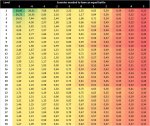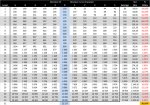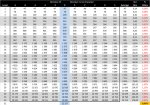Myrhdraak
Explorer
CALCULATING XP
In order to be able to calculate the right XP for monster at various levels, I have to take into account both its ability to do damage and its HP. On the player side I also add the ability to heal HP. As I have not done a full analysis of the capability to heal for the clearic at every level, I am right now just looking at 6th level and extrapolating that to the other levels, this result in a basic assumption of a player capability to heal 30% of its HP during an encounter. The result is the table below which shows how many monsters of a particular level is needed for it to be an even fight against the party.

Based on this I can now look at the 4th Edition XP curve to see if it fits the "new" game play created. Major difference will be the bounded accuracy that makes an impact on the ability to hurt monsters and PCs at a wider range of levels. I use standard deviation to look at how much the various numbers from the above graph indicates a value of the XP, forming a relation network between how hard monsters are in relation to various PC levels.

As we can se the average standard deviation expressed like a percentage of the blue values is roughly 20%, i.e. not very good. We should be able to get a curve that is more closer to the actual danger of the various monsters.
In order to be able to calculate the right XP for monster at various levels, I have to take into account both its ability to do damage and its HP. On the player side I also add the ability to heal HP. As I have not done a full analysis of the capability to heal for the clearic at every level, I am right now just looking at 6th level and extrapolating that to the other levels, this result in a basic assumption of a player capability to heal 30% of its HP during an encounter. The result is the table below which shows how many monsters of a particular level is needed for it to be an even fight against the party.

Based on this I can now look at the 4th Edition XP curve to see if it fits the "new" game play created. Major difference will be the bounded accuracy that makes an impact on the ability to hurt monsters and PCs at a wider range of levels. I use standard deviation to look at how much the various numbers from the above graph indicates a value of the XP, forming a relation network between how hard monsters are in relation to various PC levels.

As we can se the average standard deviation expressed like a percentage of the blue values is roughly 20%, i.e. not very good. We should be able to get a curve that is more closer to the actual danger of the various monsters.







